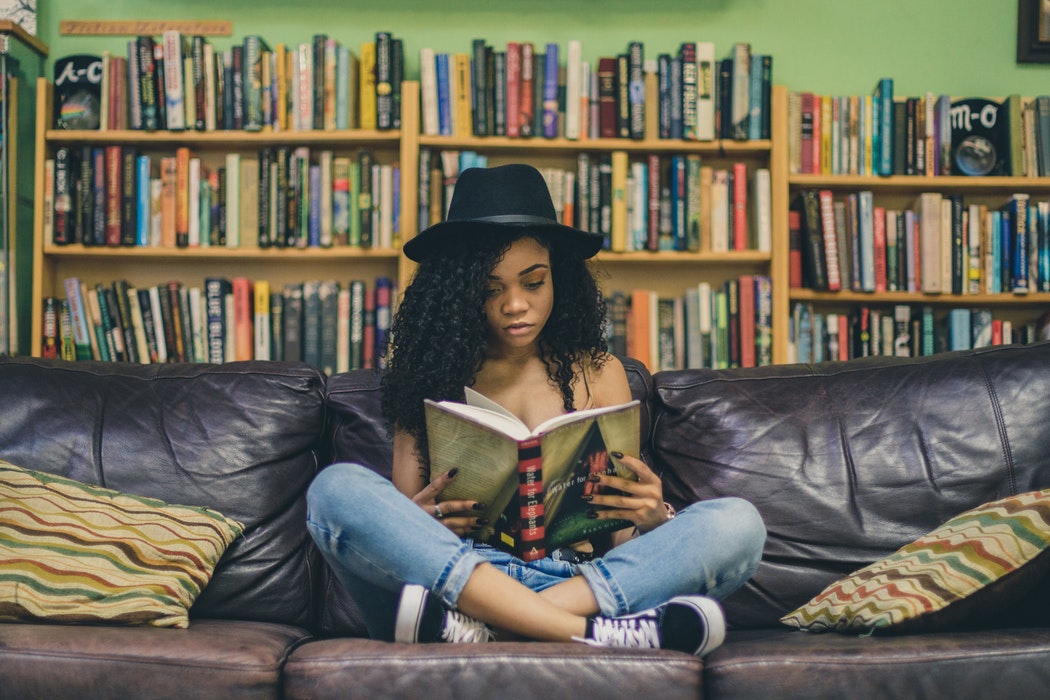What makes readers buy books – our own books or indeed any books? Knowing the answers help us we as indie authors make our books more marketable. This helpful summary of her own and others' reader surveys by by indie author and former professional researcher Maggie Lynch, collates various opinions on buying triggers and habits – all fascinating stuff.

Maggie Lynch, indie author and professional researcher
In early July I responded to a question on the ALLi Members' Facebook forum regarding reviews and bestseller status importance to the reader’s decision to buy a book. I specifically said that most reader polls I’d seen:
“In a list of 10 items that get readers to buy a book, bestseller status is #10.”
I was also asked to talk about what are the other items and where does the research come from.
The danger of making a statement like that from memory is it may not turn out to be true. So I went back through a number of studies I’d read. I’m a researcher in a past life and I scan a lot of data and research that comes across my desk about our industry and readers. For this blog I’ve chosen a variety of surveys/polls that discussed this topic and their results.
Important Points Before Reading Survey Results
Before I go into detail, as a good researcher, it is important for me to state that these sorts of reader surveys are incredibly useful, but we do have to remember that they always come with caveats. Those caveats include:
- Results for opt-in surveys are not indicative of the general readership, just those people whom we can reach with our survey.
- Surveys that are done online (which seems to be the norm for reader surveys) are also limited to those who are comfortable online. In other words, the data may apply more to those who read ebooks vs those who only read print books.
- Samples are always skewed based on the person doing the survey and the demographic they are able to reach. For example, my reader demographic is about 60% romance and 40% Science Fiction/Fantasy. So someone who doesn’t write in those genres would need to compare my results with other segments and see whether different results are uncovered.
- The data is set up to achieve a certain purpose. A person who wants to know how the readers found him/her is asking a different question than a researcher who wants to know how readers find a new author.
- The methodology used for the survey varies by the sophistication of the surveyor and what they are trying to achieve. For example, if I ask the question: “Are reviews important?” and the responses are only Yes or No; I will get different results than if I give more response possibilities such as rating on a scale of 1-4 or 1-10 or with specific wording.
- The interpretation of the results—often called the executive summary in statistical circles—is again based on the questions the researcher wanted to answer. Thus making other interpretations is definitely dicey.
All that said, I’m going to present each of these studies as best I can and let you draw whatever conclusions you wish to draw. I have noted in each one the year the survey was taken (ranges from 2010 to 2017) and what the stated research goals were (if any).
My Own Survey of What Makes Readers Buy Books (2017)
I had read reader survey results by others before doing my own in February 2017, specifically Marie Force (her results are later in this blog) and Joanna Penn. However, both of them are bestselling authors who are very successful. Joanna writes in genres I don’t. Although Marie Force does write in my field of romance, her books are very different from mine. I am a midlist writer, at best, and I’m not sure about fan loyalty. When I release a new book, I get somewhere between 200 and 700 sales in the first week, but then it drops off precipitously. I also differ from Marie’s romance career because my books are more toward Women’s Fiction with romantic elements. I also have 40% of my fan base in science fiction and fantasy.
At survey time I had an email list of just under 12,000 people. My goal was to identify what factors most influenced readers to buy a book. In the back of my head, I was wanting to know how to get readers who didn’t know me to buy my book, but that wasn’t something I was willing to take too much time to develop specific questions for.
My methodology was to list all the factors I was interested in assessing and ask them to rate the importance of each factor using a Likert scale. The four possible ratings were: Not Important, Somewhat Important, Very Important, Extremely Important. The percentages I recorded in my summary below reflect the percentage of people choosing Very Important and Extremely Important.
If you are a statistician, you know that using Likert scales are not considered to be at all exact though they are the most used survey tool for these kind of questions. It yields ordinal data—data where ordering or ranking of response is possible but not the measure of distance between responses. In other words, assigning numbers like 1, 2, 3, 4 to the answers and doing statistical analysis is problematic—though that is what we all do. The distance between Somewhat Important and Very Important is probably different than the distance between Very Important and Extremely Important.
Needless to say, I was not trying to do a PhD research paper. I was simply trying to find a quick answer to my question that I could trust enough to make decisions about where to invest time and money moving forward.
Total Responses = 3,974
The split of genre responses was close to the actual list split in my list 63% romance, 37% SFF. In comparing responses between the two genre designations, I saw no significant differences in the percentages (p=0.032).
My Audience Demographics:
• Romance demographics are 98% women ages 45+, with the largest percentage being over 55.
• SFF demographics are 67% women ages 35-55, 24% men ages 25-45
Below are the ranked results of 15 data points—again remember the percentages are people who responded very important and extremely important on each.
1. Author is well known to me (68%)
2. Book cover (53%)
3. Book recommended by a Friend (38%)
4. Book description (36%)
5. Book is part of a Series with more than one book in the series available (35%) with only one book available in the series (29%)
6. A Preview or the Look Inside feature (29%)
7. Price (21%)
8. Reviews (20%)
9. Social media recommendations through Facebook, Twitter, Instagram, Pinterest, or Google+ (17%)
10. Online advertising prompt (14%)
11. Book trailer intrigued me (9%)
12. Multiple formats were available such as ebook, paperback, audiobook (7%)
13. Well-known publishing company (4%)
14. Bestseller status USA Today or NYT bestseller stated on book cover or in book description (2%)
15. The author had won a known literary prize ( <1%)
A year later I would ask some different questions, but these were what was important to me then. Let’s look at a few other surveys to see the questions that person asked.
Macquarie University Study for Australia Council of the Arts (2016)
This is a professionally done study with a lot more months of determining methodology and then actually doing the survey. In short it involved a series of stages: organizing focus groups to formulate concerns to readers of different ages; designing the survey questionnaire; selecting the survey methodology and implementing the survey.
Unlike all other examples here, this survey had all of Australia’s population over the age of 14 as the possible group of respondents, from that they wanted a sample size of around 3,000 with a good representation of the demographics of Australia readers as a whole. They did reach that size. However, the number of actual respondents in each part of the survey differs.
I am focusing specifically on the part of the survey looking at factors influencing book selection. The researchers presented a list of possible factors and asked survey respondents to evaluate their importance based on three possibilities: not important, important, and extremely important.
Number of respondents in this section = 2,697
This is specifically from Table 10: Factors influencing book selection: percentages of respondents nominating factor as important or extremely important
1. The topic, subject, setting or style 89.7%
2. Read and enjoyed previous works by the author 77.9%
3. The book is available in the format I want 62.6%
4. Recommendation from a friend 59.7%
5. The price 44.9%
6. Reputation of the author 42.2%
7. Reader book reviews 25.4%
8. Type size 24.0%
9. People are talking about this book 23.1%
10. Professional book reviews 21.9%
11. Won or shortlisted for a prize 21.0%
12. Recommendation from a bookseller or librarian 20.5%
13. The length of the book 20.3%
14. Bestseller lists 18.6%
15. The jacket cover 18.4%
16. Promotional activity in the bookshop or library 7.9%
17. Recommendation by public figures and celebrities 7.3%
18. Cover endorsements 6.7%
The above is across all genres and ages. If you wish to look at some category differences, by age, genre, and fiction vs nonfiction, I recommend you read the linked survey.
Marie Force Reader Survey (2015)
Marie had done a survey in 2013 and decided to repeat it, while adding some demographic factors she hadn’t looked at previously and also looking at the number of readers who were part of subscription plans like KU, ScribD, Oyster, etc.
Unlike me, Marie was not specifically looking at why readers buy books. Her focus was more on sources of information to make decisions about books, as well as getting a focus on how they read (ebooks vs print); devices for ebooks (Kindle, Nook, Phone, iPad).
It is important to note that, as a romance author, Marie’s demographics are 98% female. She also states that the majority are between the ages of 35 and 55. Because the study didn’t focus on a lot of factors influencing the buying decision I was only able to pick out five from the questions she asked.
Methodology
She also used a Likert Scale with a variety of options depending on the questions.
Total Respondents = 5,990
Known Author 85% more likely to buy
Endorsements (cover blurb) 39% more likely to buy
NYT or USA Today Bestseller on the cover 26% more likely to buy
Reviews 14% matter very much, 52% matter somewhat
Pricing: If I want the book, I don’t care what the price is 52%
Mark Dawson Reader Survey 2017
On a podcast aired in 2017 Mark shared the results of his twelve-question survey. This was one is a really interesting comparator to use against the others because it is asking after the fact of purchase.
Whereas, other surveys are asking readers to talk about what influences their purchasing. Mark’s survey is asking what influenced the purchase they made of HIS books. For me, the differences in the top reasons are dramatic. It makes me wonder if what readers SAY is important, in the end is not.
In case you are not familiar with Mark Dawson, he is a very successful suspense/thriller novelist, particularly in the spy genre.
Number of Respondents = 5,700
Demographics age 54% aged 41-65, 39% 65+
Gender 65% male, 35% female
Location 60% U.S., 29% U.K.
How did they find him?
Bookbub 21%
FB Ads 16%
Amazon Also Bought Suggestion 10%
Recommendation from family or friend 5.6%
What first attracted the reader to his books?
Blurb 35%
Reviews 26%
Look Inside 21%
Cover 7%
Though other surveys didn’t ask the “How to find authors” question, it is interesting to see the impact of advertising in his survey with Bookbub and Facebook Ads holding 37%.
Whereas other surveys rank knowledge of the author and recommendation of family/friends in the top spots, for Mark they weren’t comparing him to anyone else. Seeing that the blurb was so critical reinforces my reader survey which put it at #4 after knowing the author and friend recommendations and cover. In opposition to my results, Mark’s results show the cover at only 7% which goes against a lot of common wisdom shared on the web. It seems his readers are much more involved in the written portions related to his books: blurbs, reviews, and the excerpt in the Look Inside feature.
UK Booksellers from 2010 to 2014
This paper covers several studies from 2010-2014 and, unlike the other surveys this is focused on bookstore owners and their customers. So, we are dealing with decisions around stocking print books on shelves or responding to customer requests in the UK.
I wanted to share this study for two reasons:
- It is interesting to see how things have changed from 2010 to 2014, though surprisingly not that much difference in the top items.
- Booksellers are readers too, but they also have to be concerned about if the stock will turn over in a specified period of time.
Motives for Bookstore Purchasing a Specific Book April 2014 Study
1. Subject 25%
2. Author 25%
3. Price/offer 20%
4. Series 17%
5. Characters 11%
6. Cover appeal 10%
7. Extract/inside 10%
8. Request 10%
9. Recommendation/review 9%
10. Cover blurb 8%
11. Website blurb 7%
12. Information 6%
13. Adaption 5%
14. Book 4%
15. Study/work 4%
Purchase Prompt For Bookstore to Purchase April 2012 Study
1. Subject 23%
2. Author 23%
3. Recipient request/likes 20%
4. Price/offer 17%
5. Series 13%
6. Cover look 10%
7. Recommendation/review 10%
8. Character(s) 9%
9. Looked inside 7%
10. Cover description 6%
11. Website description 6%
12. Contained info needed 5%
13. Best on subject 5%
14. Saw film/TV programme 4%
15. Read before 4%
16. Publisher 3%
17. On bestseller list 2%
18. Cheapest/Only on subject 1%
19. Advert/trailer 1%
20. Book prize 1%
Primary factor in book purchase decision January 2010
1. Author reputation 52%
2. Personal recommendation 49%
3. Price 45%
4. Book reviews 37%
5. Cover artwork/blurbs 22%
6. Advertising 14%
What influences heavy book buyers in buying books January 2010
1. Author familiarity 90%
2. Series familiarity 63%
3. Recommendations from family/friends 66%
4. Blurb on book 62%
5. Newspaper/magazine reviews 59%
6. Book cover 27%
I hope this selection of surveys has provided some insights into readers and their buying motivations. If you have any kind of email list yourself (even if it’s only 200 people), I encourage you to poll your own readers and see what they say. I believe it can be revelatory. It may even build some rapport with your readers, as they tend to like being asked what they think.
OVER TO YOU Do you have any observations of other great survey findings to add to Maggie's list? Join the conversation via the comments box!
#Indieauthors - wondering what makes readers buy books? Read @maggieauthor's comprehensive findings in this clear post Share on XOTHER GREAT POSTS ABOUT READERS & READING HABITS
From the ALLi Author Advice Center Archive






Thanks for sharing your findings with us! Actually this tallies with my reasons for buying a book…I’m more likely to buy a book I know something about in advance.
Excellent information. As expected Cover, Blurb and look inside are to top things you can do. It’s interesting to note that reviews don’t seem as important as one might think. Also, having multiple book in a series already available is seen as a plus (which makes sense.)
A bit surprising that “recommended by a friend” is so low. But there are now so many genres, it’s not a given you like the same stuff as your friends.
It’s amazing the difference in answers depending on genre and how they are asked. It makes me think about my new series and how I want to approach the cover, blurb, and promotion. Thanks, Maggie!
Maggie, this is sterling work! Thank you for your generosity in sharing this information. I particularly found interest in the sea-change of determining factors involved in making book buying decisions.
Hi Maggie:
For me, the cover, title, about the book and content are the four driving forces to each book I write. The cover photo means as much to me as the words I write inside.
Hi:
This article was wonderfully informative.
I feel I have slowly evolved to be a much better author, than I first started out to be in 2011.
Because of the advice I have followed I just finished my 3rd 2018 western frontier eBook, which will be on Amazon about the first week of September. I have the next 2 weeks to edit it in Word Office, 2016, Grammarly, my beta-reader, and then read the book out loud.
This my 31st eBook, and while I can’t brag about success or $$$$, writing seems to be what I do best.
I have a file I save all the best tips and advice found in ALLI articles and I hope other authors do too.
Thanks for the opportunity to share my opinion and research. I’d love to hear what people take from this and if it changes your own approach to where you spend your effort in promotions.